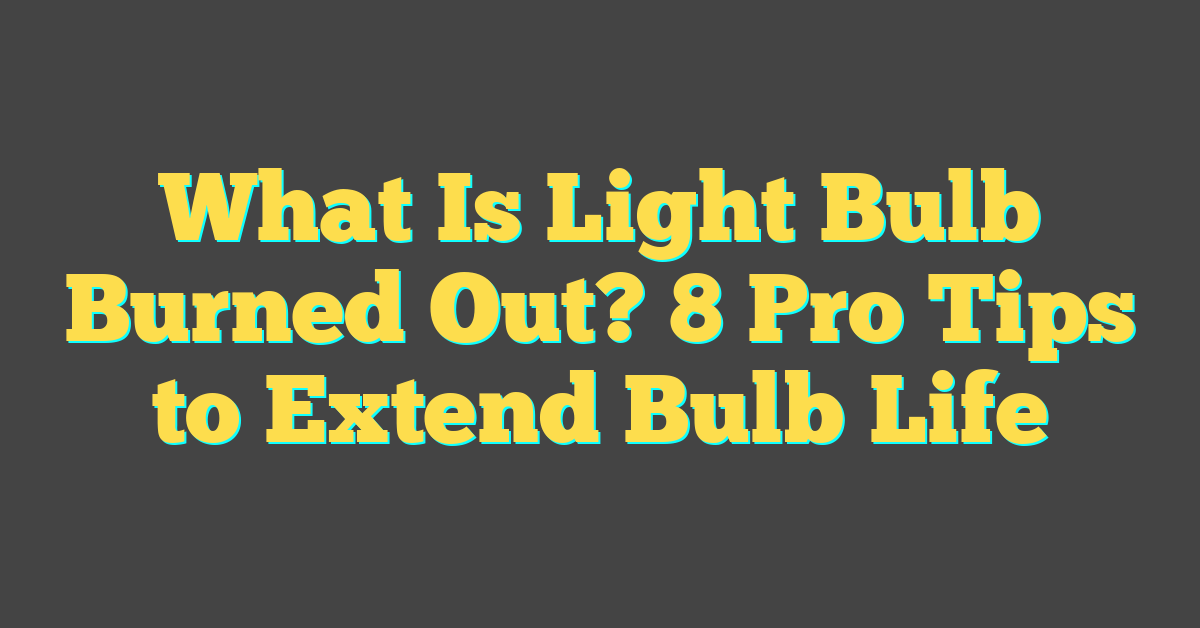Ever been mid-task when suddenly the room goes dark? Yep, you’ve got a burned-out bulb on your hands. It’s a common household hiccup, but do you know what actually causes that trusty light source to call it quits?

Light bulbs don’t last forever, and when they burn out, it’s not just about flipping a switch. There’s a fascinating science behind why bulbs give up the ghost. Stay tuned, and you’ll be enlightening your friends with more than just your new bulb.
What is a burned-out light bulb?
So you’ve clicked the switch, but instead of a cozy glow, your room remains dim.
Flickering, dimming, or altogether ceased—what’s gone wrong? You’re dealing with a burned-out light bulb, and it’s more than just an inconvenience; it’s the endpoint of a filament’s life. Inside every incandescent bulb, a thin wire, usually tungsten, glows hot to create light. With each use, the filament wears out a little more until it can no longer sustain a connection and effectively ‘burns out’.
If you’re a DIY enthusiast or simply love understanding the ‘why’ behind everyday occurrences, you’ll find the demise of a bulb fascinating. While you may not be able to save every bulb from burning out, comprehending the dynamics could save you some frustration and unexpected trips to the store.
- Tungsten Filaments: These delicate threads endure extreme temperatures. Over time, the stress causes them to weaken and eventually break.
- Evaporation: Tungsten slowly evaporates and thins the filament. This process is hastened by higher voltages, leading to a shorter lifespan.
- Bulb Blackening: Ever notice a blackening on the glass? That’s the tungsten that’s evaporated and deposited—another sign of a bulb’s impending fate.
Advancing from the common incandescent, modern lighting technology strives to lengthen bulb life. Compact fluorescents (CFLs) and Light Emitting Diodes (LEDs) work differently and often boast a significantly greater lifespan. However, they too, in their own ways, can burn out.
So next time you’re sorting through your impressive array of tools, bulging from the seams of your overstuffed garage, plotting your next home upgrade, give a thought to the humble bulb. As a connoisseur of lighting efficiency and DIY projects, embracing energy-efficient lighting might just decrease those all-too-frequent trips for replacements. After all, light bulbs, regardless of type, are crucial components in the grand scheme of your home ambiance and utility.
Why do light bulbs burn out?

As you delve into the life and death of your home’s light bulbs, it’s fascinating to discover the science behind why they burn out. Incandescent bulbs, your old-school friends, work hard. They’ve got a wire filament that heats up until it glows, giving you that warm, familiar light. But imagine running a marathon on a scorching day; that’s what the filament endures, repeatedly.
Consider this: every time you flick that switch, you send a surge of electricity that jolts the filament. Heat causes the filament to expand, and then it contracts as it cools down when turned off. This stress from thermal expansion and contraction is like bending a paperclip back and forth until it snaps. It’s an eventual farewell to your bulb.
- Material fatigue: The filament gradually grows fragile.
- Moderate shocks: Flicking the switch creates a stress cycle.
- High temperatures: Causes metals to weaken over time.
What about those black spots that mysteriously appear on the inside of the bulb? That’s the story of tungsten evaporation. Yes, the filament doesn’t just burn; it slowly evaporates and settles on the glass, a visual clue for you to plan its replacement. Handy, right?
Let’s not forget about your energy-savers: CFLs and LEDs. Compact Fluorescent Lamps (CFLs) work through a different set of rules — a chemical reaction produces ultraviolet light, which then turns into visible light. LEDs, on the other hand, use a semiconductor to produce light. Despite these improvements over incandescent bulbs, even CFLs and LEDs aren’t immune to burning out. They’re robust but not invincible.
Many factors lead to these modern bulbs calling it quits, such as:
- Power fluctuations: Can damage sensitive electronics.
- Overheating: Inadequate ventilation can shorten lifespan.
- Usage patterns: Frequent on-and-off can be just as hard on CFLs and LEDs.
The science behind burned-out light bulbs

Ever wonder why light bulbs seem to go out at the most inconvenient times? Let’s shed some light on the scientific reasons your bulbs are giving up the ghost. It’ll make your next DIY lighting project that much brighter with this knowledge.
« What Light Bulbs Are the Brightest? Discover Top LED Options
What Problem Did Light Bulbs Solve? Unveiling the Nighttime Revolution »
First off, thermal expansion and contraction play major roles. In those old-school incandescent bulbs you might have lying around, the filament heats up to produce light, but it’s also suffering. Each time you flick that switch, the sudden warmth causes the filament to expand. When you turn it off, it contracts. Over time, this repetitive stress weakens the filament, eventually leading to its demise.
Take a closer look at a well-used bulb. Notice the black spot? That’s not just any smudge – it’s actually evidence of the filament’s battle scars. The tungsten in the filament slowly evaporates and the vapor condenses on the cooler glass surface, creating that telltale black deposit.
Even your modern CFLs and LEDs are not immune to the burnout blues. Sure, they’re energy-efficient wizards, but they’ve got their Achilles’ heel too. Power fluctuations can cause premature death to the sensitive circuitry within. Add to that the potential doom of overheating due to poor heat dissipation, and you’ve got a recipe for a dark room.
What about that fixture in your bathroom you use ten times a day? Yeah, that’s not doing any favors for the lifespan of your bulbs either. Frequent on-off cycles can greatly cut short the number of hours your CFL or LED was supposed to shine.
So, there you have it – a little peek into the reasons behind your home’s occasional darkness. Knowing what causes these common issues allows you to make informed decisions about your lighting choices and usage to hopefully spend less time swapping out bulbs and more time basking in their warm glow. Keep that ladder handy – but maybe, just maybe, you won’t need it quite so often.
Factors that contribute to light bulb burnout

When you’re knee-deep in a home DIY project, there’s nothing more frustrating than a light bulb fizzling out. It’s not just luck of the draw; several key factors influence when and why your bulbs are calling it quits.
High Voltage is one of the leading culprits. Bulbs are designed to operate at a specific voltage, and even a small increase can slash the lifespan of your bulb. Peeks in voltage cause the filament to burn hotter, and that extra heat means a faster trip to burnout-ville.
Then there’s On-and-Off Cycling, which can be as tough on bulbs as it is for you to do interval sprints at the gym. The sudden surge of electricity and rapid heating/cooling put serious strain on the fragile filament, especially in incandescent bulbs. Your bulb might not show it, but it’s getting a workout.
Here’s something you might not think about: Improper Fixture Fit. You’ve got to pair the right bulb with the right fixture, just like matching a fine wine with a gourmet meal. If a bulb is too big or too snug in its fixture, heat can’t escape properly, leading to premature burnout.
But let’s not forget Environmental Factors. Bulbs in a tight, enclosed fixture or in a space with high ambient temperatures are under a lot more stress. Adequate ventilation is to a bulb what a breath of fresh air is to you.
Have you ever heard a buzzing or flickering right before the lights go out? These could be signs of Poor Electrical Connections. Loose or corroded sockets interrupt the flow of electricity and can lead to overheating and eventually, burnout. It’s like trying to run a marathon with your shoelaces untied.
Lastly, don’t overlook Manufacturer Defects. Nobody’s perfect, and sometimes a bulb slips past quality control with a flaw that’ll have it burning out faster than it should. It’s the exception, not the rule, but it happens.
By understanding these factors, adjusting your usage, and choosing the right bulb for the job, you’ll shine a light on the issue and keep those bulbs glowing strong in your home projects.
How to prevent light bulb burnout

You can save yourself the frustration of frequent bulb replacement and extend the life of your lighting investment by taking proactive steps to prevent burnout. Whether you’re a home DIY enthusiast or simply looking to maintain a well-lit space, these strategies will keep your bulbs glowing longer.
Start by Choosing the Right Bulb for the job. LEDs are known for their long lifespans and energy efficiency, while incandescent bulbs may offer a warmer glow but have a shorter functional life. Ensure you’re matching the bulb to your fixtures’ requirements and intended use.
Regulate Voltage Levels in your home by checking your electrical system. Surges and spikes can shorten the lifespan of a light bulb. Consider installing a voltage regulator or surge protector to keep the supply steady.
Manage On-and-Off Cycling by installing timers or smart home systems that minimize unnecessary switching. Remember, the less frequent the cycling, the longer your bulbs will last.
When installing bulbs, ensure that you:
- Fit bulbs snugly but don’t overtighten them, as this may damage the socket and the bulb’s base.
- Use bulbs with the Proper Wattage for your fixtures to avoid overheating.
- Protect Outdoor Bulbs with fixtures designed to withstand environmental factors like wind and rain.
For those fixtures frequently used, consider investing in High-Quality Bulbs. They may come with a higher upfront cost, but the longevity and reduced replacement frequency can lead to savings in the long run.
Finally, don’t overlook the importance of Regular Maintenance. Dust and dirt can accumulate on bulb surfaces and in fixtures, leading to overheating. Wipe bulbs and fixtures with a dry cloth periodically to ensure they’re clean.
Remember, treating your light bulbs with care not only prevents burnout but also enhances the ambiance of your space. With a little attention and the right choices, you can enjoy uninterrupted, optimal lighting that sets the perfect mood for your home.
Conclusion
You’ve got the power to keep your home shining bright without the frequent hassle of changing bulbs. By making smart choices about the bulbs you buy and taking a few simple steps to care for them, you’ll not only save time but also money in the long run. Remember, it’s the small changes in how you use and maintain your lighting that can make a big difference. So go ahead, give your bulbs the attention they deserve and they’ll return the favor with a longer, more luminous life.
Frequently Asked Questions
What are some strategies to prevent light bulb burnout?
To prevent light bulb burnout, you should choose suitable bulbs for your needs, regulate voltage levels, manage the frequency of switching lights on and off, ensure proper installation, use correct wattage, protect outdoor bulbs, buy high-quality bulbs, and perform regular maintenance.
How do I choose the right bulb for my needs?
Select a bulb based on the intended use, preferred brightness (lumens), energy efficiency, color temperature (warm or cool light), and bulb shape that fits the fixture.
Can voltage levels affect the lifespan of a bulb?
Yes, inconsistent or overly high voltage levels can reduce the lifespan of a bulb. Using a voltage regulator can help prevent premature burnout.
How does on-and-off cycling affect light bulbs?
Frequent on-and-off cycling can cause thermal stress on light bulbs and lead to earlier failure. To minimize this, use bulbs rated for high switching cycles in areas where you turn lights on and off frequently.
Why is installing a bulb properly important?
Proper installation prevents electrical shorts and poor connections that can cause flickering and reduced bulb life. Make sure bulbs are screwed in firmly, but not too tightly.
Does using the proper wattage make a difference?
Yes, using a bulb with wattage too high for the fixture can lead to overheating and rapid bulb failure. Always adhere to the fixture’s recommended wattage.
How can I protect outdoor bulbs from burning out quickly?
For outdoor bulbs, use bulbs specifically designed for outdoor use with weatherproof features to withstand temperature fluctuations and moisture.
Is investing in high-quality bulbs worth it?
High-quality bulbs often have better construction and materials that can withstand stress better, allowing them to last longer and provide more value over time.
What kind of maintenance can extend the life of my bulbs?
Regularly cleaning bulbs and fixtures to remove dust and dirt can improve efficiency and lifespan. Also, check for wiring issues and replace fixtures if necessary to ensure proper functionality.




